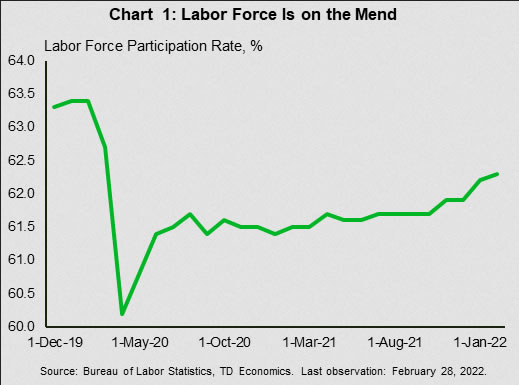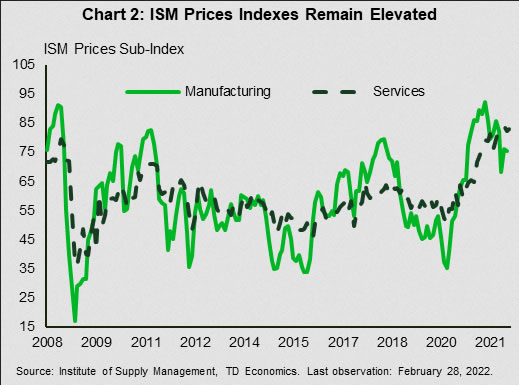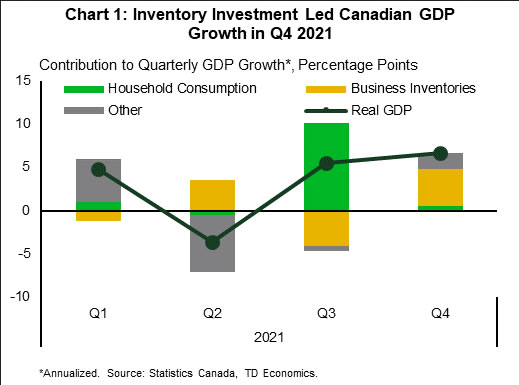U.S. Highlights
- The labor market added 678k jobs in February, and the unemployment rate fell to 3.8% – the lowest reading since the pandemic began.
- Early indicators suggest that manufacturing and services sectors were out of sync in February, with the former accelerating and the latter slowing down. The difference is largely attributed to continued weakness in demand for services.
- The Russia-Ukraine War continues to reverberate through financial markets, lifting commodity prices and threatening to tighten financial conditions further. The Fed is likely to raise interest rates in March, but the speed of future rate hikes is more uncertain.
Canadian Highlights
- The Bank of Canada raised the overnight rate by 0.25 percentage points to 0.5%, citing strong economic data and the absorption of economic slack.
- The Canadian economy grew by a robust 6.7% annualized in the fourth quarter of 2021, enough to remove any remaining economic slack created by the pandemic.
- Financial stress has increased as a result of the war in Ukraine. This will be an important indicator to watch in considering the future path of monetary policy and economic growth.
U.S. – Economy Marches On, Volatility Spikes due to the Russia-Ukraine War
It’s the first week of March, which means we get the initial glance at how the economy did in February, when the Omicron wave started to ease. This morning, the U.S. Bureau of Labor Statistics surprised the market with 678k jobs created in February, well above 400k anticipated by forecasters. This was on top of an upward revision of 92k to December and January. The unemployment rate fell to 3.8 % – the lowest reading since the pandemic, just 0.3 percentage points above the level two years ago. The labor force – a measure of people working or actively looking for work – also made progress. The labor force participation rate ticked up to 62.3% after 304k people joined labor force in February (Chart 1). All in all, labor market is getting tighter and tighter.
In the meantime, leading business indicators diverged. As measured by the ISM Index, the manufacturing sector reversed three months of decline, accelerating to 58.6. Demand was solid, with new orders moving above 60 again. Production accelerated, but it could have been even stronger without materials supply constraints. The backlog of orders index jumped by almost 9 percentage points (ppts), while supplier deliveries inched 0.5 ppts higher. Despite all these challenges, inventory rebuilding continued, albeit at a very slow pace adding only 0.4 percentage points in February.
Surprisingly, the services sector slowed in February, with the two demand indicators – business activity and new orders – declining to mid-50 levels, last seen exactly one year ago. The consensus anticipated a modest increase, expecting that the fading threat of Omicron would help the services sector bounce back. Respondents blamed the post-holiday fatigue and difficult business conditions, affected by capacity constraints, inflation, logistical challenges, and labor shortages. Indeed, supply-side indicators deteriorated as delivery times slowed again while the employment index moved back into the contractionary territory.
The price sub-indexes remained elevated, although price pressures seem to track lower in the manufacturing sector, while services continue to struggle with a reading above 83 (Chart 2). Despite these differences, there is little doubt that next week’s CPI reading will come in much higher than the 2% target. With the threat of higher prices becoming more entrenched, the Fed is unlikely to hesitate to raise the fed funds rate by 25 basis points on March 16th.
Meanwhile, Russia’s invasion of Ukraine has reverberated through financial markets, lifting a key measure of volatility to the highest level in more than a year. Although the U.S. trade dependency on Russian and Ukrainian products is limited to less than 1% (according to the World Bank), the U.S. economy may suffer through other channels. The conflict has already resulted in the biggest weekly surge in commodity prices since 1974, and threatens to exacerbate pandemic-induced logistical challenges. Both of these forces will lead to higher prices, and a drag on economic growth. Meanwhile, further deterioration in financial conditions would be equivalent to monetary tightening, which could force the Fed to slow down the speed of rate hikes in the future.
Canada – Rate Hikes Have Commenced
Surprising no one, the Bank of Canada kicked off its path to normalizing monetary policy from the extraordinary setting it has maintained through the pandemic. On Wednesday, the Bank raised its key lending rate by 0.25 percentage points to 0.5%, the first in what is likely to be a string of rate hikes.
The Bank of Canada’s decision came on the heels of the release of economic data for the fourth quarter of 2021 that showed the Canadian economy growing by a robust 6.7% annualized on the quarter and 4.6% for the year as a whole. The economy grew strongly to end the year, even as household spending was relatively soft and spending on goods edged lower. Instead, growth was led by businesses increasing production in order to rebuild inventories that had been dwindled by the combination of supply constraints and past strong sales (Chart 1).
The Bank’s rate decision comes as the global economy is thrown into a period of heightened uncertainty due to the Russian invasion of Ukraine. The war in Ukraine will worsen supply constraints and exacerbate inflationary pressures. There is little the Bank of Canada can do to prevent that. It does, however, have a lever to, as governor Tiff Macklem noted in a speech following the decision, “lower the parts of inflation that are driven by domestic demand.” Higher borrowing costs will slow demand in interest rate sensitive sectors of the economy, like housing, that have experienced the most rapid price appreciation through the pandemic. Monetary policy will not slow inflation on a dime, but rate increases today are necessary for returning the trajectory of inflation lower over the next year.
In addition to rate hikes, the Bank of Canada will begin normalizing its balance sheet, which ballooned to over 20% of GDP as a result of large scale asset purchases of government bonds. Governor Macklem came out strong in his messaging on the central bank’s plans for quantitative tightening (QT), noting that the maturity of the Bank’s holdings is relatively short, and by simply allowing them to mature, the Bank could move close to its pre-pandemic stance over the next two years. Communicated in advance, QT is unlikely to put significant upward pressure on interest rates, but it will slow deposit growth and contribute to tighter financial conditions.
Stress in financial markets will be an important indicator to monitor in gauging future monetary policy decisions as well as the economic outlook. So far, credit spreads have remained relatively contained, widening but not yet to worrisome levels (see Chart 2). Equity market volatility has increased, but North American stock markets have moved sideways rather than significantly lower. The TSX has performed better than other indexes, reflecting its energy tilt. As of writing, it was up on the week. This may not last. Financial volatility and stress is likely to worsen the longer the conflict continues.





 Signal2forex.com - Best Forex robots and signals
Signal2forex.com - Best Forex robots and signals




